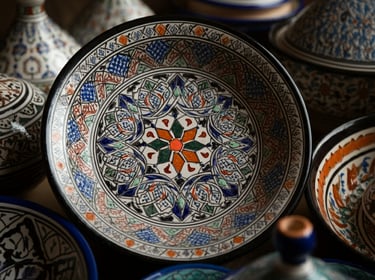The Abundant Heritage of Moroccan Pottery
CULTURE & HERITAGE


Moroccan tableware has a profound and historical heritage, intricately woven into age-old traditions passed down through generations of adept craftsmen. The skill of crafting crockery in Morocco goes beyond simple craftsmanship; it embodies cultural history, showcasing the nation's numerous influences, its close connection to nature, and the essence of its people. The vivid hand-painted ceramics of Fez and the earthy, rustic Rif Mountains works exemplify Moroccan dinnerware's significance in the worldwide admiration of traditional workmanship. Let us thoroughly examine the history, influences, and importance of this exquisite art form.
Moroccan Crockery's Origins and Initial Influence Archeological evidence traces the history of Moroccan pottery back thousands of years, to the Phoenician and Carthaginian periods, approximately 1000 BCE. Nonetheless, the skill significantly thrived under the Berber (Amazigh) tribes, the indigenous populace of Morocco, who were among the first immigrants. These cultures produced utilitarian items, such as cooking pots, water jars, and storage containers, with indigenous clay. These innovations were fundamental to daily existence and crafted to fulfill practical requirements. Following the emergence of Arab influence in the 7th century, Moroccan pottery started its evolution, molded by Islamic art and architecture. The Arabs introduced novel methods and ornamental designs, including geometric patterns and elaborate floral themes, which are frequently seen in Islamic art. The amalgamation of Berber and Arab traditions established the unique Moroccan dinnerware style, which continues to enthrall artists and collectors.
The "Golden Age" of Moroccan Pottery Moroccan ceramics reached their zenith during the Almoravid and Almohad kingdoms, which ruled from the 11th to the 13th centuries. This era, often known as the "Golden Age" of Moroccan art and culture, was characterized by vibrant creative expression. Cities such as Fez and Marrakesh emerged as flourishing hubs of craft and workmanship, attracting craftsmen from across the Islamic world. The potters of Fez, notably, transformed crockery into an art form. The city became renowned for its elaborately adorned ceramics, particularly the unique blue-and-white patterns influenced by Chinese porcelain but infused with local customs. Referred to as "Fassi pottery," these elaborate creations serve as quintessential symbols of Moroccan artistry. Artisans in Fez also perfected the craft of zellige, a kind of mosaic tilework composed of glazed terracotta tiles. This method emerged as a hallmark of Moroccan architecture, adorning palaces, mosques, and public edifices with intricate designs and vivid hues. In addition to the proliferation of tilework, Fez potters gained recognition for their exceptional artistry in both utilitarian and ornamental objects. These painters fused regional forms, combining Berber workmanship with Arab-Islamic inspirations, thus establishing a distinctive aesthetic that endures in contemporary Moroccan tableware. Moroccan pottery exhibits regional variability. The geographical uniqueness of Moroccan tableware makes it distinctive. Various regions of Morocco developed unique ceramic traditions, shaped by local surroundings, materials, and cultural behaviors. The rustic simplicity and earthy hues of Berber pottery in the Rif and Atlas Mountains set it apart. These artifacts, often handcrafted and kiln-fired in open-air settings, embody the relationship between the craftspeople and their environment. Berber crockery has geometric designs that symbolize a profound connection to the earth. Berber potters' creations often fulfill utilitarian functions, including cooking, storage, and routine domestic activities. Safi, a seaside city renowned for its ceramics, manufactures a distinct style. Artisans produce handpainted items embellished with vivid hues and elaborate patterns. Safi pottery is renowned for its striking flower designs, animal themes, and intricate workmanship. The city's closeness to the Atlantic Ocean has resulted in an abundance of native clay, enabling Safi to emerge as one of Morocco's foremost hubs for pottery manufacture.
The Artistry of Moroccan Pottery A prominent feature of Moroccan tableware is its traditional workmanship. The production of pottery in Morocco is a laborious endeavor that needs a blend of expertise, ingenuity, and perseverance. Artisans often begin by sourcing clay from local deposits, which they then clean and mold into diverse shapes manually or using a potter's wheel. Decoration, which varies by area, follows the shaping procedure. In Fez, the elaborate decorations often include geometric patterns and traditional themes. Vibrant colors often coat these items, with cobalt blue being a notably renowned shade in Fassi ceramics. Conversely, the potters of the Atlas Mountains often produce simple, unglazed items that honor the intrinsic beauty of the clay. The concluding phase involves firing the pottery in kilns. Certain locations, especially rural ones, use traditional open-air kilns, but major towns like Safi and Fez utilize more contemporary fire techniques. The firing process may last several days, requiring artists to meticulously oversee the temperature to guarantee the pottery's durability and the appropriate setting of the glazes.
Moroccan ceramics and cultural identity Moroccan tableware transcend mere use and decoration; it embodies the nation's multifaceted cultural character. The colors, patterns, and designs narrate the extensive history of Morocco, amalgamating Berber, Arab, Andalusian, and African elements into a unified entity. Every pottery item, whether it is the exquisite blue-and-white Fez ceramics or the Rif's coarse earthenware, embodies a profound feeling of cultural pride and identity. Moroccan ceramics serve as a conduit between history and contemporary times. Artisans continue to pass down skills through generations while also exploring innovative ideas and materials. The equilibrium between tradition and innovation has sustained the trade, guaranteeing that future generations of Moroccan potters will refine their abilities and maintain their history. Sustainability and Moroccan Pottery In recent years, Moroccan ceramics have been increasingly focused on sustainability. To reduce manufacturing's ecological footprint, artisans are increasingly prioritizing the use of sustainable materials and procedures. Numerous potters get their clay locally, minimizing shipping requirements and bolstering local economies. Moreover, conventional fire techniques, including open-air kilns, demand fewer resources compared to contemporary industrial kilns. Nevertheless, several artists are using new energy-efficient kilns to further reduce their carbon impact. By emphasizing ecological procedures, Moroccan potters are guaranteeing the longevity of their art for future generations. The Worldwide Allure of Moroccan Ceramics Moroccan pottery currently enjoys global esteem due to its aesthetic appeal, artisanal quality, and cultural significance. The international market for Moroccan pottery has increased, attracting collectors, interior designers, and aficionados. The enduring allure of Moroccan dinnerware lies in its ability to harmonize form and function, artistry and practicality, tradition and modernity. Numerous worldwide markets, especially in Europe and North America, have adopted Moroccan dinnerware as both an artistic expression and a cultural item. It underscores the profound interrelations of workmanship, culture, and history.
Summary
The Moroccan dinnerware's history exemplifies Morocco's ingenuity, adaptation, and cultural persistence. Moroccan dinnerware, from its ancient roots to its prominence throughout the Islamic dynasties, has developed into a diversified and esteemed art form that reflects the nation's rich past. Currently, Moroccan pottery captivates individuals globally, providing a concrete link to the artists who have developed this extraordinary talent over generations. As global interconnectedness increases, the allure and importance of Moroccan tableware will only amplify. Whether located in the vibrant souks of Fez or shown in residences globally, each item narrates a tale— a tale of heritage, artistry, and cultural pride.
